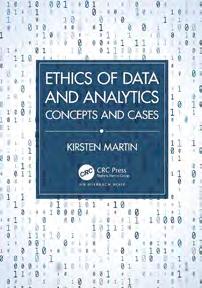
10 minute read
WOMEN IN DATA & AI
Book Recommendations
BY NICOLE JANEWAY BILLS
NICOLE JANEWAY BILLS is the founder & CEO of Data Strategy Professionals. She has four years of experience providing training for data-related exams and offers a proven track record of applying data strategy and related disciplines to solve clients’ most pressing challenges. She has worked as a data scientist and project manager for federal and commercial consulting teams. Her business experience includes natural language processing, cloud computing, statistical testing, pricing analysis, ETL processes, and web and application development. She attained recognition from DAMA for a Master Level pass of the CDMP Fundamentals Exam.
In an era when algorithms make decisions about hiring, healthcare, and so much more, it’s refreshing to see a wave of influential books written by women who are deeply involved in shaping these technologies. Each author featured here highlights a distinct aspect of data and AI, from uncovering bias and advocating for inclusive design to translating complex technical challenges into practical guidance for organisations. These reads offer more than technical insights: they reveal how AI and analytics collide with social values, cultural contexts, and human needs. Whether you’re a data practitioner seeking fresh perspectives or simply curious about the intersection of technology and ethics, the voices captured in these five titles will broaden your understanding of what it means to create responsible, forward-looking solutions.
YOUR AI SURVIVAL GUIDE: SCRAPED KNEES, BRUISED ELBOWS, AND LESSONS LEARNED FROM REAL-WORLD AI DEPLOYMENTS
Authors: Sol Rashidi
Time to read: 7 hrs 28 mins (224 pages)
Rating: 4.7/5 (63 total ratings)
As an early adopter who helped launch IBM Watson in 2011, Sol Rashidi brings hands-on experience to implementing AI in business environments. She presents a practical approach that cuts through the hype, offering guidance for non-technical leaders who need to understand and deploy AI effectively.
The book stands out for its use of real-world examples across multiple industries – from retail to healthcare, energy to agriculture. Through these case studies, Rashidi demonstrates how different organisations have navigated the complexities of AI implementation, sharing both successes and setbacks. Her insider perspective on working with leading AI companies provides valuable context for understanding what’s possible and what’s premature.
What sets this book apart is its focus on the human side of AI deployment. Rashidi addresses the common obstacles that arise when introducing AI into established organisational processes, from securing executive buy-in to preparing teams for change. She provides frameworks for identifying suitable AI applications and building support among stakeholders who may be sceptical or hesitant.
The book gives special attention to the gap between
ARTIFICIAL INTELLIGENCE:
A GUIDE FOR THINKING HUMANS
Author: Melanie Mitchell
Time to read: 11 hrs 12 mins (336 pages)
Rating: 4.6/5 (904 total ratings)
Melanie Mitchell, a computer science professor and veteran AI researcher, clarifies the complex world of artificial intelligence. She begins by charting AI’s origins in fields such as computer vision and neural networks before connecting these ideas to modern-day machine learning breakthroughs. Rather than claim that AI is poised to eclipse human intelligence tomorrow, she points to the gaps in current algorithms and shows how easily they can be led astray by ordinary inputs. This viewpoint reveals where human judgment still trumps computation. Her approach is refreshingly straightforward. For instance, Mitchell distinguishes between ‘narrow’ AI – systems tuned for specific tasks – and the broader, more flexible intelligence we exhibit in everyday life. She touches on successes, such as high-level game-playing systems, but reminds us that real-world problems rarely have perfect rules or neat boundaries. Drawing on her academic background, she explains key topics such as natural language processing without veering into overly dense theory.
A key strength of this book lies in its reflection on
1AI’s potential and its practical implementation. Rashidi offers specific techniques for evaluating AI opportunities and managing expectations, which is particularly valuable for organisations taking their first steps with this technology. Her emphasis on starting small and scaling gradually provides a realistic roadmap for businesses at any stage of AI adoption.
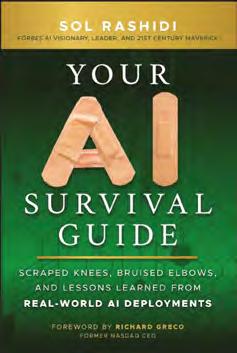
Throughout the book, Rashidi’s conversational tone helps ensure that readers outside the technical realm remain engaged. She avoids heavy jargon, choosing to prioritise clarity over arcane explanations of algorithms or code. Her anecdotes emphasise the importance of strong project ownership, proper resource allocation, and setting realistic timelines. In doing so, she dispels the myth that AI initiatives are always highstakes moonshots. Instead, she shows how organisations can reach meaningful results by focusing on tangible benefits and maintaining flexible structures.
TL;DR: A practical guide for organisational leaders implementing AI based on real-world experience rather than theoretical possibilities. Focuses on actionable strategies and common pitfalls to avoid.
2the relationship between AI and human cognition. Mitchell brings up how biases in training data mirror societal issues and how interpretability remains a challenge, especially for large models. She also addresses pressing ethical questions around automation, emphasising that humans should remain active decision-makers in how AI evolves. By weaving in her own experiences and careful analysis of well-known experiments, she presents AI as a rapidly developing field still in need of critical thinking and ongoing research.
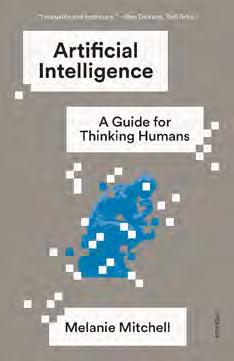
Mitchell is a master at exploring how AI systems actually work, what they can and cannot do, and what these limitations mean for their role in our future. This perspective helps readers move beyond both excessive hype and unwarranted fears about AI technology.
TL;DR: A clear-eyed examination of artificial intelligence’s current capabilities and limitations, written by an expert who knows how to make complex concepts accessible without losing technical accuracy.
UNMASKING AI: MY MISSION TO PROTECT WHAT IS HUMAN IN A WORLD OF MACHINES
Authors: Joy Buolamwini
Time to read: 11 hrs 12 mins (336 pages)
Rating: 4.6/5 (159 total ratings)
In her latest book, Joy Buolamwini shares her journey from tinkering with robotics as a high-school student in Memphis to her work at MIT’s Media Lab, where she uncovered bias in widely used facial recognition technologies. These systems often perform poorly on individuals from certain racial or gender groups, and her evidence shook the tech community. In describing this ‘coded gaze,’ she reveals how unexamined assumptions can seep into AI and produce harmful outcomes at scale.
What distinguishes this work is its focus on practical solutions. Rather than simply critiquing AI’s problems, Buolamwini outlines specific steps for building more equitable systems. She examines how intersecting forms of bias – including racism, sexism, and ableism – create compounding effects in AI applications, affecting everything from healthcare access to criminal justice.
The book shows that algorithmic errors are more than technical glitches; they can amplify inequality. Buolamwini recounts how these flaws motivated her to found the Algorithmic Justice League, an initiative that strives for
ETHICS OF DATA AND ANALYTICS: CONCEPTS AND CASES
Author: Kirsten Martin
Time to read: 11 hrs 40 mins (352 pages)
Rating: 5/5 (2 total ratings)
Kirsten Martin examines the ethical dimensions of data analytics through a practical lens in her latest book. Whether an organisation is collecting user information for targeted marketing or applying algorithmic risk assessments for employee evaluations, Martin makes it clear that these choices carry serious consequences. She offers a range of ethical frameworks to guide readers in assessing the impact of analytics at every step, reminding us that being ‘datadriven’ does not necessarily mean being just or fair.
The book is structured around three core themes. First, it explores how data analytics programs inherently embed values that affect moral outcomes. Second, it emphasises the critical role of design in shaping these outcomes. Third, it examines how data analytics and AI systems distribute power, investigating who benefits and who faces marginalisation. Unlike many texts that search for universal answers, Martin takes a more nuanced approach. She neither condemns technological progress outright nor does she blindly endorse it. Instead, she presents a balanced view that invites critical thinking about transparency and responsibility. Through examples, she highlights how organisations can violate privacy or reinforce harmful biases
3
accountability and ethical guidelines in AI development. While her research focuses on facial analysis tools, her broader aim is to caution that any poorly audited AI can reinforce stereotypes and perpetuate injustices.
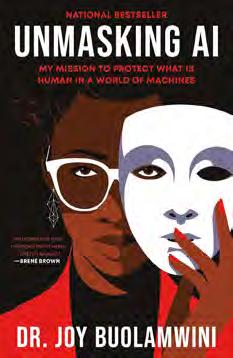
Buolamwini encourages readers to look beyond shortterm commercial goals and instead examine how new technologies shape civic life. She calls upon policymakers, developers, and the public to demand transparency in automated systems. By drawing on examples from her own investigations and ongoing advocacy, she highlights how public pressure can spur companies to improve their products and avert discriminatory outcomes.
TL;DR: A researcher’s firsthand account of uncovering bias in AI systems, combined with a practical roadmap for building more equitable technology. Explains complex technical concepts while keeping focus on their human impact.
4
when they don’t question the algorithms they build and deploy.
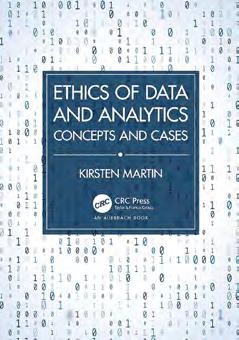
Martin pays particular attention to questions of accountability, privacy, and surveillance. She demonstrates how seemingly technical decisions about data collection and analysis carry substantial moral weight, affecting individual rights and dignity. The book shows how standard business decisions in analytics create ripple effects that extend far beyond immediate business objectives. Her background as a technology ethics professor underpins her arguments, grounding them in both real-world practicality and academic rigour. Ultimately, the reader is encouraged to view data analytics not just as a path to efficiency or profit but as a domain where human dignity and rights can be protected or eroded by design.
TL;DR: A practical examination of ethical decisionmaking in data analytics, focusing on how technical choices affect human rights and dignity. Uses real cases to demonstrate how different ethical frameworks can guide better system design.
NICOLE JANEWAY BILLS
INVISIBLE WOMEN: DATA BIAS IN A WORLD DESIGNED FOR MEN
Authors: Caroline Criado Perez
Time to read: 14 hrs 32 mins (436 pages)
Rating: 4.6/5 (12,076 total ratings)
Caroline Criado Perez’s meticulous research underscores how our data-driven world often overlooks half its population. By treating men’s experiences as the baseline, products and policies inadvertently fail to address women’s specific needs. Through a range of cases – from medical research to urban planning – Perez shows how everyday decisions can disadvantage women, often in surprising ways. She references data gaps in crash-test dummies, for example, that can lead to higher injury rates for female drivers. These gaps emerge in places as routine as office temperature standards or smartphone sizing.
The book goes beyond exposing shortcomings; it addresses the tangible consequences for women’s health, productivity, and economic advancement. At the same time, Perez offers evidence-based steps toward more inclusive practices, calling for better representation in data collection and a broader effort to question existing assumptions. Her
5approach aims to shift mindsets rather than simply point out inequities: if designers and policymakers ask more inclusive questions, they might arrive at solutions that serve everyone more effectively.

While the subject matter can be unsettling, Perez’s writing remains direct and informative, letting realworld examples speak for themselves. By spotlighting the hidden costs of treating men’s data as the default, she illustrates how more inclusive data practices can improve outcomes across all demographics.
TL;DR: A data-driven examination of how the failure to collect and analyse gender-specific information has created a world that systematically overlooks women’s needs, with consequences ranging from daily inconvenience to substantial harm.
Conclusion
The women behind these works bring clarity, expertise, and personal experience to a field that too often glosses over its deeper implications. They remind us that data is never just data – it carries the weight of human decisions, beliefs, and potential biases. By looking at AI through their eyes, we gain a more nuanced picture of how these systems are built, deployed, and regulated. We hope these recommendations spark fresh ideas and greater awareness of the human stakes in AI and data analytics. Whether you’re managing AI projects, debating the ethics of automation, or simply looking to better understand the world of technology, these authors show the importance of questioning existing assumptions. In so doing, they also shine a light on new pathways for growth, innovation, and respect for the people who engage with these systems every day.
